Physical Address
304 North Cardinal St.
Dorchester Center, MA 02124
Early diagnosis of structural anomalies is increasingly possible. About half of the congenital anomalies can be diagnosed in the late first trimester.
Severe and often lethal anomalies can be diagnosed, allowing parents the options of continuing with the pregnancy or, if acceptable, termination of pregnancy.
Women appreciate the opportunity of early reassurance or early diagnosis, making this scan an essential first step in screening for congenital anomalies.
First trimester ultrasonography (US) was first introduced for accurate dating of pregnancy based on the crown–rump length (CRL) measurement and diagnosis of multiples. However, the rapid improvement in US imaging in the late 1980s proved that structural anomalies could already be detected in the first trimester. Key to this development was the introduction of transvaginal US, which enabled a more detailed visualisation of first trimester fetuses.
Since then numerous reports on early diagnosis of fetal anomalies have followed. The focus was initially on high-risk pregnancies but gradually extended towards more unselected populations.
After the introduction of the most powerful marker for aneuploidies – the nuchal translucency (NT) measurement – US investigation between 11 and 14 weeks has become the cornerstone of standard pregnancy care in many countries worldwide, either as part of screening programs for aneuploidies or as first global risk profile assessment in pregnancy.
The Fetal Medical Foundation (FMF) has played a crucial role in setting standards and providing training and certification for the performance of first trimester screening, and in 2013, the International Society of Ultrasound in Obstetrics and Gynecology (ISUOG) addressed in a guideline the various aspects of US investigation in the first trimester of pregnancy, aiming at promoting standardisation and uniformity.
Overall, in an unselected population and in a routine setting, about 40% to 50% of the structural anomalies can potentially be detected in the first trimester, although considerable variations exist among studies, reflecting operator and population characteristis. Severe and often lethal anomalies are detected in 100% of cases.
A recent systematic review concludes that 30% of structural anomalies are detectable at first trimester examination, and the detection can double to 60% when the examination follows a structured protocol.
It is clear that the yield of first trimester US goes far beyond screening for fetal aneuploidy and should therefore be considered an essential part of routine care for all women, next to noninvasive screening for aneuploidies. There is little doubt on the role of first trimester US as first step in ruling out severe congenital anomalies. What is still missing is a consensus on when this investigation should be performed (12–14 weeks), on the preferred approach (transabdominal or transvaginal) and how extended it should be. It is also important to explain to parents what can be detected and the limitations of an early US examination.
The mobility of the first trimester fetus can be challenging for the examiner, but it can also enable a quick visualisation of different fetal planes within a short time. The use of cine loop is crucial for this purpose and can expedite first trimester US examination. Investigation of the fetal head and of the upper thorax, in the same plane used for the NT measurement, also provides information on the nasal bone (NB) and on brain structures, including the diencephalon, the brainstem and the fourth ventricle with its choroid plexus ( Fig. 19.2 ). The fourth ventricle appears as a rectangular structure called intracranial translucency (IT) delimited by two echogenic lines. Another longitudinal midsagittal view, including the whole fetal trunk, allows visualisation of the diaphragm, of the entire abdominal wall and intraabdominal contents, including bladder filling and size. The fetal spine, although not yet completely ossified, can also be observed along its whole extension from the cervical origin to the sacrum. By tilting the probe on both sides of the fetal body, the extremities are visualised together with the long bones. A first trimester fetus has commonly open hands, easily enabling counting of fingers. The legs are often flexed and the feet close to each other so that in a single sweep, their positions can be assessed. Cross-sectional planes from cranial to caudal show in the head the image of the falx (midline) and of the choroid plexuses, filling at this stage almost entirely the relatively large lateral ventricles. Of note is that the size of the lateral ventricles (usually 6–8 mm) does not change after 12 to 13 weeks. The typical aspect of the falx and of the two-echogenic structures in the lateral ventricles has been called the ‘butterfly sign’.
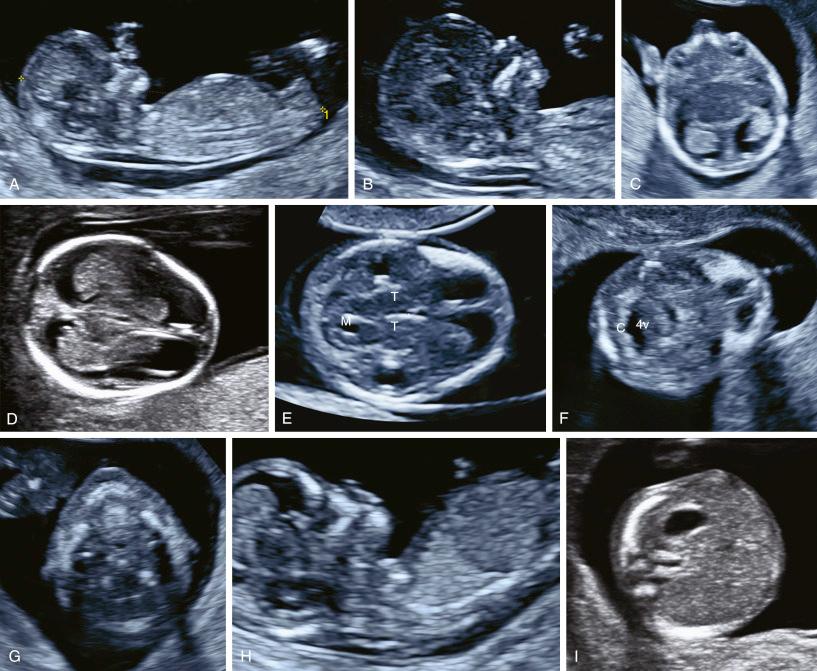
| Organ or anatomical area | Present and/or normal |
|---|---|
| Head | Present Axial Cranial bones Midline falx Choroid plexus–filled ventricles Midsagittal Brainstem thickness a Fourth ventricle (IT) a |
| Neck | Normal appearance NT thickness if accepted after informed consent and trained or certified operator available) a |
| Face | Eyes with lens a Nasal bone Normal profile and mandible Intact lips |
| Spine | Vertebrae (longitudinal and axial) a Intact overlying skin |
| Chest | Symmetrical lung fields No effusions or masses |
| Abdomen | Stomach present in left upper quadrant Bladder Kidneys a |
| Abdominal wall | Normal cord insertion |
| Extremities | Four limbs, each with three segments Hands and feet with normal orientation |
| Placenta | Insertion (with respect to CS scar) |
| Cord | Number of vessels Insertion on the placenta |
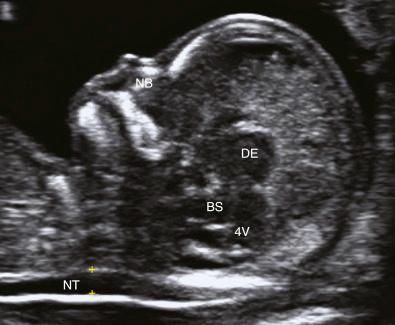
A cross-sectional view of the thorax at the level of the four-chamber view allows visualisation of the heart axis and of the size of atria and ventricles ( Fig. 19.3A ), whereby use of colour, or even better directional power Doppler, is a crucial complement to two-dimensional imaging for rapid visualisation of cardiac structures. This includes filling of the chambers ( Fig. 19.3B ), exclusion of atrioventricular valve regurgitation (more commonly seen across the tricuspid valve), visualisation of the crossing of the outflow tracts and confluence of the aortic arch and ductal arches forming a V (V-sign) pointing towards the left shoulder of the fetus with (colour) flow in the same direction ( Fig. 19.3C and ![]() ). More caudally, the fetal stomach is seen under the heart just above the level of the umbilical cord insertion. Finally, lower in the pelvis, the bladder is seen, flanked by the two umbilical arteries. The kidneys can occasionally be observed as two more echogenic oval structures on both sides of the spine. This quick and gross anatomical survey enables exclusions of major and mostly lethal structural anomalies such as acrania, exencephaly, holoprosencephaly, gross spinal anomalies, abdominal wall defects, megacystis and gross skeletal or limb deformities. Appreciation of the heart axis and of the four-chamber view and outflow tracts by colour Doppler excludes gross cardiac anomalies. Although in favourable circumstances, a transabdominal (TAI) scan performed with high-resolution US systems gives excellent images, in obese women or in case of a retroverted uterus, the transvaginal approach can be indicated and improve structure visualisation. In obese women, a transvaginal US can provide even better images than a transabdominal midtrimester scan. Recently, high-frequency linear array probes have been introduced for use in early fetal anatomical assessment. In lean women, this probe can provide excellent images, especially of the fetal heart.
). More caudally, the fetal stomach is seen under the heart just above the level of the umbilical cord insertion. Finally, lower in the pelvis, the bladder is seen, flanked by the two umbilical arteries. The kidneys can occasionally be observed as two more echogenic oval structures on both sides of the spine. This quick and gross anatomical survey enables exclusions of major and mostly lethal structural anomalies such as acrania, exencephaly, holoprosencephaly, gross spinal anomalies, abdominal wall defects, megacystis and gross skeletal or limb deformities. Appreciation of the heart axis and of the four-chamber view and outflow tracts by colour Doppler excludes gross cardiac anomalies. Although in favourable circumstances, a transabdominal (TAI) scan performed with high-resolution US systems gives excellent images, in obese women or in case of a retroverted uterus, the transvaginal approach can be indicated and improve structure visualisation. In obese women, a transvaginal US can provide even better images than a transabdominal midtrimester scan. Recently, high-frequency linear array probes have been introduced for use in early fetal anatomical assessment. In lean women, this probe can provide excellent images, especially of the fetal heart.
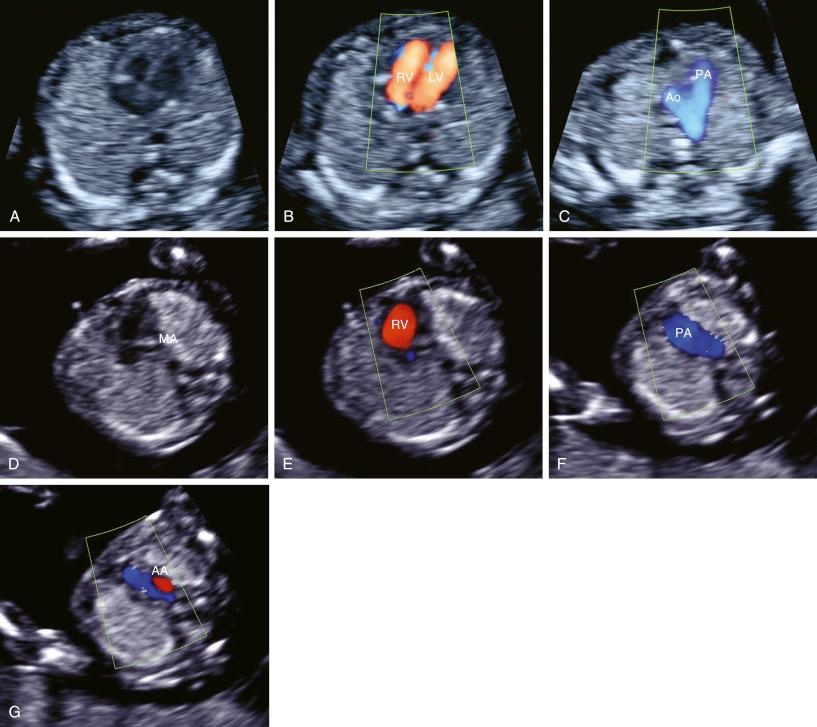
The largest study to date, on 44,850 euploid fetuses examined at the time of the nuchal scan, showed that structural anomalies were observed in 1.1% of cases. Overall 43% of the structural anomalies were detected at the first trimester scan, and the NT was enlarged in 30%. The authors state that about one-third of the structural anomalies are amenable to early diagnosis, and about 40% can potentially be detected in the first trimester. The remaining 30% cannot be detected as they become evident or develop only at later stages in pregnancy. Another study confirmed that 45% of the structural anomalies and 100% of the severe ones are amenable to early diagnoses. The NT was enlarged in 50% of cases. A recent meta-analysis of 19 studies (115,731 fetuses) on first trimester US investigation shows an overall DR for structural anomalies of 46%. In low-risk pregnancies, the DR was 32% and increased to 60% in high-risk groups and when a protocol was used.
In euploid fetuses, excessive nuchal fluid accumulation (large NT, cystic hygroma) can be regarded as a strong marker for an ever-growing list of structural and genetic disorders and poor pregnancy outcomes. The chance of a poor outcome depends on the initial degree of enlargement. The strongest association exists for cardiac defects, with NT being enlarged in about 40% of the major cardiac defects.
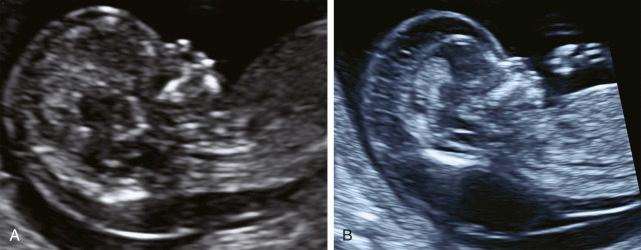
Of all genetic syndromes, the most commonly associated with an increased NT is Noonan syndrome, a relatively common syndrome. (See more on this in the paragraph Genetic syndromes.)
An enlarged NT is a common denominator to many developmental disorders, appearing to be a nonspecific US marker shared by different pathways.
In the attempt to refine risk assessment based on NT screening, other markers have been investigated and added to the algorithm. The first one was an absent or hypoplastic NB followed by an abnormal ductus venosus (DV) flow (absent or reversed a wave). More recently, the appreciation of tricuspid regurgitation (TR) has been described.
An absent NB is common in trisomies, but some genetic syndromes also share this feature. An abnormal DV is especially associated with cardiac defects, although this association is still poorly understood.
Becker and Wegner found in 3094 fetuses investigated at the 11 + 0 to 13 + 6-week scan that an NT of more than 2.5 mm was observed in 58 of 86 (67.44%) fetuses with a structural anomaly.
Syngelaki found a highly significant association between NT above the 95th percentile and acrania ( P < .0001), diaphragmatic hernia ( P = .007), exomphalos ( P < .001), megacystis ( P < .0001), lethal skeletal dysplasia ( P = .0002), bilateral talipes ( P = .012) and body-stalk anomaly ( P < .0001) and in cases with multiple defects ( P < .0001). A large study from the United States found that an increased NT gives a threefold increased risk for hydrocephaly, lung and diaphragm anomalies, bowel obstruction and skeletal disorders.
In another study including 6858 fetuses, Becker and colleagues found that of all the 220 anomalies (including aneuploidies) present in the cohort (prevalence, 2.8%), 111 (1.7%) were observed in fetuses with a normal NT. Therefore their conclusion was that although the association between an enlarged NT and structural fetal anomalies is a given fact, if the aim of the first trimester scan is to diagnose as many anomalies as possible, fetuses with a ‘normal’ NT should be thoroughly investigated because about 50% of the anomalies will be found in this significant group (8.3%).
The workup after an enlarged NT includes array comparative genomic hybridisation (CGH) investigation and repeat scans. Arrays reveal in these fetuses an additional 5% of pathological copy number variants. If the nuchal oedema has completely disappeared in the second trimester and the 20-week scan findings are normal, the chance of an abnormal outcome is extremely low and not dissimilar from the normal population.
The first publication on first trimester US examination of fetal brain appeared in 1989. The importance of early diagnosis of central neural system (CNS) anomalies lies in the fact that anomalies are common, often lethal or associated with severe mental disability or motor dysfunction. Early detection offers parents the option to terminate the pregnancy at a stage when termination may be less traumatic.
Brain development and maturation continue throughout pregnancy. Neurodevelopment starts from the neurulation phase, from around 19 days of embryonic life to around day 26. The neural plate becomes the neural tube, and this further develops into prosencephalon (forebrain), mesencephalon (midbrain), rhombencephalon (hindbrain) and the spinal cord. At the time of the first trimester scan (11–13 weeks), rudimentary brain structures are present and can be assessed by US.
Cranial bone ossification should be completed by 11 weeks. It is helpful to look specifically for bone ossification in the axial and coronal planes. No bony defects (distortion or disruption) of the skull should be present. Lateral ventricles are relative large and filled by the echogenic choroid plexuses in their posterior two thirds (see Fig. 19.1D ). The hemispheres appear symmetrical and separated by a clearly visible interhemispheric fissure and falx (see Fig. 19.1D ). The thin brain mantle is best appreciated anteriorly, lining the large fluid-filled ventricles, an appearance which should not be mistaken for hydrocephalus. At this early age, some cerebral structures (e.g., corpus callosum, cerebellum) are not yet sufficiently developed to allow accurate assessment.
The midsagittal view of the fetal head, routinely used for the assessment of NT thickness and NB at 11 to 13 weeks, can also be used to assess early fetal brain anatomy. The configuration of the midbrain, brainstem and fourth ventricle changes in case of open spina bifida (OSB). The IT, corresponding to the fourth ventricle, has been proposed as marker for normal brain development and intact spine. In case of OSB, the biparietal diameter is already affected from the first trimester and is relatively smaller than the head circumference. Also, cystic abnormalities of the posterior fossa (Dandy-Walker complex) can be occasionally detected.
There has been some debate as to which view, midsagittal or axial, is the most informative for early investigation of fetal brain abnormalities. The midsagittal (or preferably parasagittal or sagittal-oblique views) is useful for screening purposes, but in case of suspected intracranial findings, the use of parallel axial planes and three-dimensional (3D) neurosonography at referral centres may refine the final diagnosis.
Neurosonography can already be performed at 12 to 13 weeks, transabdominally with use of high-frequency transducers (in lean women), or transvaginally. The use of five axial views can exclude the most common anomalies amenable to early diagnosis ( Fig. 19.5 ). 3D US (box placed around the skull and sweep starting from the ‘butterfly view’) can help systematic assessment in parallel axial views (plane A), and sagittal reconstructed planes (plane C) are used for topographic orientation in the axial planes.
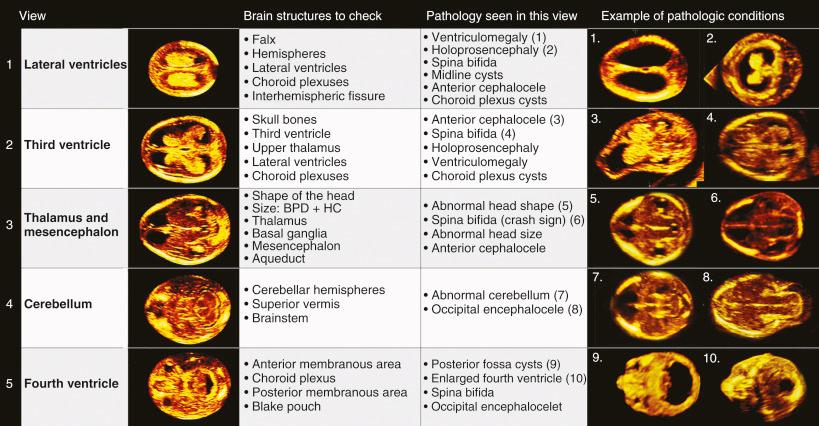
Acrania ( Fig. 19.6 ) (prevalence, ∼3.7 in 10,000 pregnancies), is caused by failure of closure of the rostral part of the neural tube. In this condition, the cranial bones and scalp skin have not developed, and the brain tissue is exposed to mechanical and chemical damage. Eventually, brain tissue ‘dissolves’ in amniotic fluid, producing a ‘milky’ appearance on scan ( Fig. 19.6B ). Later in pregnancy, acrania evolves into exencephaly and in the second trimester into anencephaly, in which hardly no more brain tissue is visible. Acrania can be in 12% of cases part of chromosomal or genetic condition (Meckel-Gruber syndrome) or amniotic band syndrome and is associated with aneuploidy in up to 5% of cases. Sonographic features of acrania are present from 9 weeks. The usual presentation of acrania at 11 to 13 weeks is an irregular contour of the head in sagittal plane and absent or severe deficiency of cranial bones with distortion of the brain structures ( Fig. 19.6A and ![]() ). To not miss this condition, an early scan should be performed after 11 weeks by trained sonographers.
). To not miss this condition, an early scan should be performed after 11 weeks by trained sonographers.

Other rare conditions that can be diagnosed early in gestation are iniencephaly and craniorachischisis, the latter morphologically similar to acrania.
Encephalocele or cephalocele ( Fig. 19.7 ) (1 in 5000 live births) is a neural tube defect characterised by protrusion of intracranial structures through a defect in the skull. The first trimester detection rate is 80%. It is suggested that the anomaly is associated with an enlarged rhombencephalic cavity at earlier US investigation and that absence of one of the three posterior brain spaces can be helpful to identify fetuses with cephalocele.
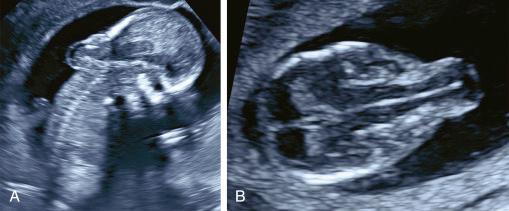
By visualisation of the fetal skull defect in the axial plain, a differentiation can be made between cranial meningoceles (only protrusion of meninges; 37% of cases) and encephaloceles (protrusion of brain tissue into the cephalocele; 63% of cases) ( ![]() ). 3D US can be helpful to clearly image the defect. Additional fetal malformations are seen in 65% of cases. The prognosis is variable and depends of associated conditions, localisation, size and anatomical structures involved. The anomaly can evolve to exencephaly. Some defects can lead to intrauterine death.
). 3D US can be helpful to clearly image the defect. Additional fetal malformations are seen in 65% of cases. The prognosis is variable and depends of associated conditions, localisation, size and anatomical structures involved. The anomaly can evolve to exencephaly. Some defects can lead to intrauterine death.
Become a Clinical Tree membership for Full access and enjoy Unlimited articles
If you are a member. Log in here